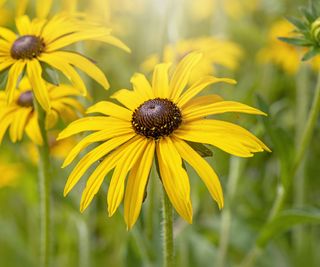If your soil is less than perfect, you may be wondering if there are any plants that thrive in poor soil. Don’t worry, there are actually quite a few plants that can thrive in poor soil. Let’s face it, not everyone has fertile loam soil. Not everyone has the time or money to invest in improving their soil, but they still want a landscape filled with plants. Are you interested in plants that thrive in poor soil? Read on to learn about plants that thrive in poor soil, and surprisingly, they can grow almost anywhere.
About Plants for Poor Soil
Most plants prefer a rich, well-drained, sandy loam soil with plenty of organic matter. This soil meets the needs of most, but not all, plants. Some plants actually prefer less hospitable soils.
So if you are looking for plants for poor soil, you should determine what type of soil you are working with. A soil test can help you determine that. You can then narrow down the plants that will suit your specific soil environment along with the amount of sunlight, if any, that location needs.
Top 8 Best Plants for Poor Soil
Once you have determined what type of soil you have, it’s time to choose plants. This can be difficult, so I’ve compiled a list of the 8 best plants for poor soil.
1. Lavender

(Image source: Mariia Demchenko/Getty Images)
I can attest that lavender can be difficult to grow; in the consistently wet PNW. However, when I moved to a different area, lavender seemed to be the flowering herb of choice. It is extremely tolerant of a wide range of soils from compact to rocky, but it must have good drainage and at least 8 hours of sun or more. Provide this fragrant beauty with these two conditions, and you will have a hardy, long-lasting option for almost any soil type in your landscape.

Munstead Heirloom Lavender Seeds
This English lavender variety can grow in the toughest of places and still delight you with its blooms all summer long.
2. Heuchera

(Image source: Kyaw_Thiha / Getty Images)
Areas with lots of trees are often problematic areas for planting trees. The roots of the trees may only be a few inches deep, leaving little room for anything with a deeper root system. In this case, heuchera (also known as coral bells) is a great choice. Not only does heuchera come in a variety of beautiful leaf colors, it also has a shallow root system and prefers shadier conditions beneath a row of trees.
3. Coneflower

(Image source: Fasil Tiru / 500px / Getty Images)
Comb flower (Purple daisy) is native to the prairies of North America. This hardy flowering perennial comes in a variety of colors that will liven up dull areas of the landscape. It is drought and moisture tolerant and thrives in poor soils such as compacted clay. It is also a magnet for beneficial pollinators.

Echinacea Purpurea ‘Mellow Yellows’
This hardy native flower has buttery yellow petals and can thrive even in arid soil.
4. Arborvitae

(Image source: Pawel Kacperek / Getty Images)
If you’re looking for a fast-growing shrub/tree that’s not fussy about placement, try an arborvitae. This evergreen grows quickly to form a privacy screen but is not fussy about soil quality. Although it can be grown in partial shade, arborvitaes prefer full sun. There are several varieties, some of which can grow to over 40-60 feet (12-18 m) tall while others are more moderate at 15 feet (4.5 m).
5. Butterfly grass

(Image source: Ed Reschke / Getty Images)
Butterfly grass (Asclepias radish), another North American native and a type of milkweed, can be grown in USDA zones 3-9 in soils ranging from clay to sandy. Fairly hardy, butterfly weed blooms with numerous orange flowers in the spring. Plant butterfly weed in full sun, where it will grow to about 1-2 feet (30-61 cm) tall and wide. A prolific nectar producer, its common name refers to the large number of butterflies it attracts.

Asclepias Tuberosa ‘Hello Yellow’
This flower from Green Promise Farms will keep pollinators coming back for more.
6. Sedum or sedum plant

(Image source: Jacky Parker Photography / Getty Images)
I am a big fan of perennial sedums and have several in my landscape. Part of the Family Crassulaceae This family includes about 600 species in the Northern Hemisphere, including shrubs, perennials, annuals, and climbers. They thrive in shallow, sunny, well-drained soils that are sandy or rocky. All have succulent leaves and clusters of small, colorful flowers and can be grown in USDA zones 3-9. Incense is extremely hardy and drought-tolerant, making it a good choice for rock gardens and xeriscaping.
7. Black-eyed Susan

(Image source: Jacky Parker Photography / Getty Images)
An extremely hardy perennial, Black-eyed Susan (Rudbeckia hirta) can be grown in USDA zones 3-10. These plants are extremely cold-hardy and can also tolerate high temperatures and humidity. They are not affected by poor soils such as heavy clay or sand. Prized for their consistent sunny orange blooms with black centers, black-eyed Susans spread in the garden by self-seeding and rhizomes.
8. Honeysuckle

(Image source: igaguri_1 / Getty Images)
The most fragrant honeysuckle is a large, diverse group of shrubs or small trees with clusters of often strongly scented flowers. Despite their delicate flowers, honeysuckle is actually a hardy plant and thrives in a wide range of soil types in USDA zones 3-8 in full sun to partial shade. Most honeysuckle shrubs bloom from spring through June, followed by attractive fruit and stunning fall foliage.
